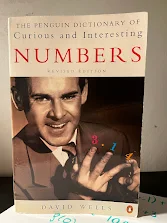70
This entry is taken from the dictionary, which is that seventy is the smallest weird number. What this means is that the factors of seventy (barring seventy itself) don't sum to seventy in any way.
So the factors of seventy are 1, 2, 5, 7, 10, 14 and 35. No matter how hard you try, you can't add any selection of them to get to seventy - add them all up and you get 74, exclude 1 and you get 73, exclude 2 as well and you get 71, exclude only 5 and you get 69...you get the picture. And seventy is the smallest of all the weird numbers, so it's the smallest weird number.
Perfect numbers
On the opposite end of the spectrum, you have perfect numbers, where all the factors of the number (barring the number itself) add up to the number. Take six, for example: 6=1+2+3.
Or 28: 1+2+4+7+14. Or 496, 8128... Numbers which do this but with a selection of factors are semiperfect, such as 24, which can equal 12+8+4.
On another note, we only know of even perfect numbers, and there's an open question over whether we'll find an odd perfect number - all the factors would be odd, so we'd need an odd number of odd factors so to not accidently end up with an even number after adding all the odd numbers. Whether that number exists or not can be something for you to find out.
Schizophrenic numbers
It's not every day you see a mathematical concept named after a condition in the DSM 5, but today is that day. Either way, these are numbers that are irrational, yet have certain rational qualities.
The first time such a number was discussed was on an internet forum, with the function f(x)=10f(x)+x, setting f(0)=0, at the heart of it. Initially, the sequence is 1, 12, 123, 1234, and so on. Square root the values, and you get a nice undulating sequence with the outputs starting with 11111... or 35136...
This all comes to a head at the square root of f(49), which results in the number that can be found on this website which explains these numbers better (as well as having more info), where certain numbers repeat in ever-shortening strings, before a mix of numbers come afterwards. This Wikipedia article is also handy.
Champernowne's constant
0.123456789101112131415...
It's a simple number in execution - every single base-10 integer from 0 up to infinity can be found in this expansion, sitting somewhere next to the one before and after it. It's also a straightforward example of what is known as a transcendental number, that is a number which isn't the solution to a polynomial, and a category which e and π belong to. However, it's even more interesting as it's an example of a normal number, which is a number where every number is equally likely to appear, which the constant does because it's intended to have every base-10 integer from 0 up to infinity sitting somewhere next to the one before and after it. Therefore, there's an equal probability that you'll find it. Another normal number is the Copeland-Erdos number, which is 0.235711131719..., which has every prime number from 2 to infinity in it.
You'd think normal numbers would be opposing to weird numbers, which makes it slightly odd that a weird number is nothing like a normal number by definition.
418 - I am a teapot
418 holds an extremely important and serious role in maintaining the internet - as part of the Hyper Tex Coffee Pot Control Protocol, error code 418 is "I am a teapot". If you ever see this message on a webpage, you should be confused.
Another unique one is error code 451, where a webpage is not available legally - the number is a reference to Ray Bradbury's novel Fahrenheit 451.
For more numbers that I've blogged about, read my posts on i, e and φ.

Comments
Post a Comment